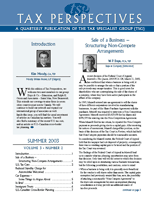
PDF Format
 Issue Contents Issue Contents
 All Issues All Issues
Summer 2003
Volume 3, Number 2
The information in Tax Perspectives is prepared for general interest only. Every effort has been made to ensure that the contents are accurate. However, professional advice should always be obtained before acting on the information herein.
Reduced Standby Charge For Automobiles Welcomed
By Ralph H. Green, CA, TEP
Ralph H. Green & Associates
Where an employer provides an automobile to an employee, a personal benefit is assessed based on two-thirds of the lease cost or 24% of the capital cost of the vehicle. This is over and above a benefit for paying for the employee's gasoline, insurance and repairs. Prior to 2003, the standby charge would only be reduced if personal use was less than 10%. The new rules for the calculation of the standby charge, introduced in the recent federal budget, will reduce standby charges for employer-provided automobiles for a significant number of taxpayers. Commencing in 2003, the standby charge will be reduced if both: - personal use of the automobile is less than 1,667 kilometres per month (increased from 1,000 kilometers per month); and
- the automobile is used "primarily," (i.e., more than 50%) for business purposes.
The employer must require the employee to use the car to carry out employment duties, and this should be evidenced in a written employment contract. When all the tests are met, the standby charge is reduced by business travel. Thus, if an employee has greater than 50% business use, the reduction will be available. Example 1
An employee uses an automobile costing the employer $35,000. The standby charge, before the reduction for low personal use, is $8,400 (24% of the original cost of the car). The car was available for 12 months and was driven 10,000 personal kilometers and 30,000 business kilometers. The standby charge for 2003 will be $2,100, 25% of what would previously have resulted. Example 2
Asports car is leased for $2,000/month, or $24,000 a year. The standby charge would have been $16,000 (two-thirds of the lease cost). Assume the car was driven 12,000 personal kilometers and 36,000 business kilometers. The standby charge would now be $4,000. Example 3
The sports car above is leased by the employee directly, and an allowance of $2,000 per month is paid to the employee. The allowance is a taxable benefit and is included in income. The employee may deduct the lease payments, subject to pro-ration based on personal use, and a ceiling on deduction of around $9,600. This will result in a benefit of about $16,800 ($24,000 less $9,600). Clearly, employer leasing is far better, except that the employer is now stuck with not being able to deduct the full lease payments. Comments on the New Rules The changes will mean that more employees with employer-provided automobiles will qualify for the reduction for low personal use. Now it is more important than ever to keep personal driving to a minimum by: - Planning trips to maximize business mileage;
- Using an alternative vehicle for personal mileage. For example in two-car families, use the personal car for personal use rather than the company car, whenever possible; and
- Making business calls on the way to or from work to convert personal kilometers to business kilometers.
Other factors such as selecting a vehicle that does not meet the definition of an automobile may also reduce the benefit associated with an employer owned vehicle. Typically a 1/2 ton truck with one bench seat may qualify for this treatment. The easiest way to reduce your standby charge and keep the taxman at bay is to keep a good business log of your mileage. Without hard evidence, CCRA are typically not very receptive to reducing the standby charge even if it is obvious that you should qualify. While it is not legislated that you keep a log, it is good business practice. The reduced standby charge has another side benefit. In lieu of calculating the actual taxable benefit for employer-paid gasoline, insurance, maintenance, etc., a benefit of 50% of the standby charge may be used instead. Under the new reduced standby charge, this may be far lower than in the past, and may prove beneficial. Cars depreciate quickly. Some say that a new car drops in value by 20% when driven out of the dealer's parking lot. The standby charge for a vehicle owned by the employer is based on its original cost. If it is transferred to a related company after, say, one year, a new and much reduced cost will then apply for purposes of the standby charge calculation.
|